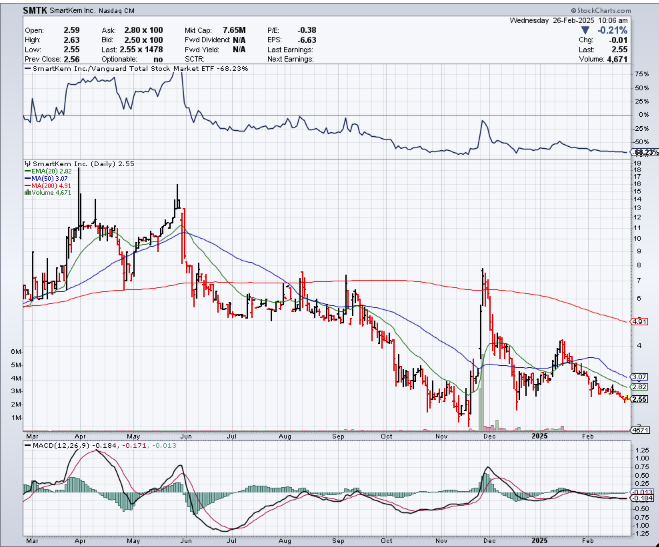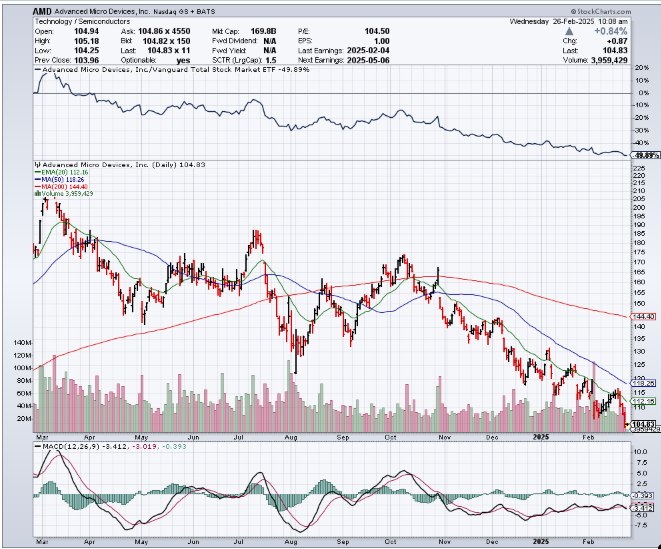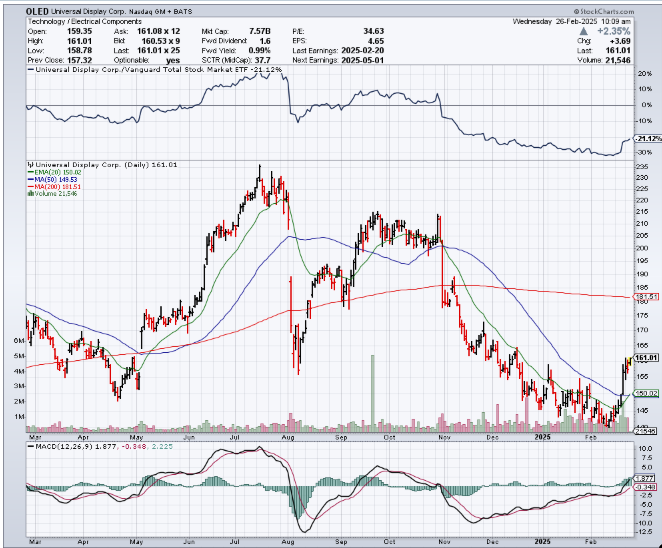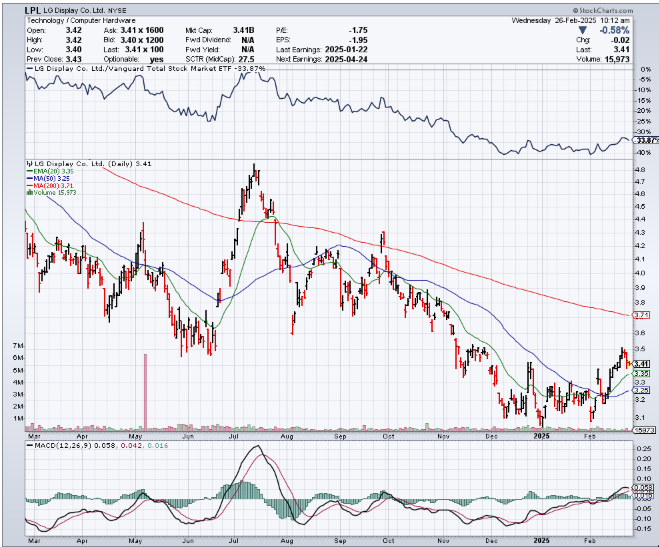The future of display technology is unfolding before our eyes, reshaping how we experience everything from smartphones and smartwatches to immersive entertainment and automotive interfaces. With cutting-edge advancements in MicroLED, OLED, and AMOLED displays, as well as breakthroughs in flexible and transparent screens, the industry is undergoing a seismic shift.
This booming sector is projected to surge from $159.2 billion in 2023 to $215.09 billion by 2032, driven by the relentless demand for brighter, more energy-efficient, and ultra-responsive displays.¹ Major players in consumer electronics, healthcare, and automotive industries are racing to capitalize on these innovations, creating a lucrative opportunity for investors.
Here are five display technology stocks to watch in 2025, each positioned at the forefront of this rapidly evolving market:
-
Smartkem, Inc. (NASDAQ:SMTK)
-
Advanced Micro Devices, Inc. (NASDAQ:AMD)
-
Universal Display Corporation (NASDAQ:OLED)
-
LG Display Co., Ltd. (NYSE:LPL)
-
Himax Technologies, Inc. (NASDAQ:HIMX)
1. Smartkem, Inc. (NASDAQ:SMTK)

MicroLED technology is widely regarded as the future of displays, offering superior brightness, energy efficiency, and durability compared to OLED and LCD screens. However, despite its advantages, widespread adoption has been hindered by high production costs, complex manufacturing processes, and low yields. These challenges have kept MicroLEDs largely confined to high-end applications, limiting their potential in consumer electronics, automotive, and medical displays.
Smartkem, Inc. (NASDAQ:SMTK), a British company specializing in organic thin-film transistor (OTFT) technology, is developing a manufacturing process that resolves these issues. The company’s low-temperature transistor technology could change MicroLED display production, making it cheaper, more scalable, and easier to integrate into existing manufacturing lines. Instead of relying on high-precision mass transfer and laser welding techniques that have resulted in low yields and high costs in MicroLED production, Smartkem’s OTFTs allow for direct pouring of its liquid transistors onto the MicroLEDs using flexible plastic substrates at just 80°C. This eliminates some of the most expensive and failure-prone steps in the manufacturing process, improving production yields and reducing costs.
This technology is already gaining industry interest. Smartkem, Inc. (NASDAQ:SMTK) recently partnered with AUO, Taiwan’s largest display manufacturer, to co-develop the world’s first rollable, transparent MicroLED display.² AUO’s interest in Smartkem’s technology reflects the industry’s search for alternatives to traditional silicon-based transistor backplanes, which have proven costly and inflexible for next-generation displays.
If successful, this collaboration could help accelerate the commercialization of flexible and transparent MicroLED displays, which are expected to play a significant role in wearables, automotive dashboards, and next-generation consumer electronics.
MicroLED adoption is expected to rise rapidly to reach over $21 billion by 2027, reflecting an impressive 81.5% compound annual growth rate (CAGR).³ Much of this growth is expected in consumer electronics, where displays generated over $50 billion in revenue in 2023,⁴ and in wearables, where the smartwatch market alone is projected to reach $106.5 billion by 2025.⁵ The automotive sector isn’t far behind, with digital dashboards and HUDs pushing the market toward $27 billion by 2030.⁶ Smartkem (NASDAQ:SMTK) is on the cutting edge of this transformation, developing OTFT technology that has the potential to make MicroLEDs more scalable and cost-effective—removing key barriers to mass adoption.
Smartkem, Inc. (NASDAQ:SMTK) has built a solid intellectual property position, holding 138 granted patents across 17 patent families and 40 trade secrets. This extensive IP portfolio provides a critical competitive advantage as companies look for ways to overcome the production hurdles associated with MicroLEDs.
The company has also established strategic co-development agreements with Chip Foundation on MicroLED backlighting for LCDs⁷ and recently completed its first sale of TRUFLEX® semiconductor materials to Chip Foundation under their co-development agreement,⁸ FlexiIC on smart sensor circuits, and ITRI (Industrial Technology Research Institute) on commercial-scale product prototyping.
While the promise of MicroLEDs is clear, manufacturing challenges have remained a significant barrier. Smartkem’s OTFT technology presents a potential solution, offering a lower-cost, more scalable alternative to traditional manufacturing methods. As major display manufacturers search for ways to bring MicroLEDs to mainstream markets, Smartkem’s ability to integrate with existing production infrastructure could make it a key player in the industry’s next phase of growth.
With co-development agreements with industry leaders like AUO and an expansive IP portfolio, Smartkem, Inc. (NASDAQ:SMTK) is set to disrupt the MicroLED market, which is expected to reach $21 billion by 2027.⁹ With the ability to expand into high-growth sectors like wearables, automotive, and healthcare, Smartkem’s technology has the potential to reshape how displays are made, unlocking new possibilities for a wide range of industries. The completion of its first sale of TRUFLEX® semiconductor materials and its focus on 2025 goals mark a promising future for the company’s continued growth and innovation.
Sponsored
The MicroLED market is set to explode from $592M to $21B by 2027.
That’s a whopping 81.5% CAGR.
Tech giants like Samsung, Meta and Apple are already positioning themselves
But one rising powerhouse is stepping into the spotlight with technology that has the potential to deliver the next generation of MicroLED displays.
2. Advanced Micro Devices, Inc. (NASDAQ:AMD)

Advanced Micro Devices, Inc. (NASDAQ:AMD) is a prominent player in the semiconductor industry, recognized for developing cutting-edge products that drive high-performance computing, graphics, and data centers. AMD’s processors, including the Ryzen and EPYC series, are widely used in personal computing and server solutions. Its graphics technologies, most notably the Radeon line, empower the gaming and professional markets.¹⁰
Through its graphics cards, AMD is also deeply involved in display technology, supporting advanced visuals such as 4K resolution, high dynamic range (HDR), and multi-display setups. Additionally, its FreeSync technology reduces screen tearing and stuttering, enhancing gaming performance.
Recent developments highlight AMD’s strategic collaborations and robust financial performance. On February 11, 2025, AMD announced an exciting partnership with France’s Commissariat à l’énergie atomique et aux énergies alternatives (CEA), a leader in energy research and technological innovation.¹¹ The collaboration will focus on advancing AI compute, leveraging AMD’s advanced hardware to support the growing demands of AI and machine learning. This venture strengthens AMD’s role as a key player in AI infrastructure, offering powerful solutions for data centers and high-performance computing environments.
Additionally, on February 4, Advanced Micro Devices, Inc. (NASDAQ:AMD) revealed its financial results for the fourth quarter and full year of 2024, showcasing solid growth despite a challenging market landscape.¹² AMD reported increased revenue, driven by a surge in demand for its EPYC processors, which have become the go-to solution for cloud service providers and enterprise customers. The company’s ability to cater to evolving technological needs continues to position it as a leader in the industry.
In another notable partnership, AMD recently teamed up with G42, a prominent UAE-based technology firm, to enable AI innovation in France.¹³ This strategic investment aims to boost AI capabilities and further enhance France’s role as a technology leader. By working with G42, AMD aims to strengthen AI research and development in Europe, particularly in high-performance computing, where the demand for powerful AI tools is rapidly expanding.
These announcements reflect AMD’s ongoing dedication to innovation, investment in global AI ecosystems, and its focus on delivering performance-driven solutions. AMD’s future looks bright as it continues to shape the semiconductor landscape and lead technological advancements across various industries.
3. Universal Display Corporation (NASDAQ:OLED)

Universal Display Corporation (NASDAQ:OLED) is a leading innovator in OLED (Organic Light Emitting Diode) technology, specializing in the development of high-performance OLED materials and devices. Through its proprietary UniversalPHOLED® technology, UDC provides the foundation for creating energy-efficient, high-brightness OLED displays used in products such as televisions, smartphones, automotive displays, and more.¹⁴ The company has played a pivotal role in the advancement of OLED technology, contributing to its widespread adoption across various industries.
In their fourth-quarter and full-year 2024 financial results, UDC showcased strong performance driven by robust demand for OLED materials.¹⁵ The company reported increased revenue, with a significant rise in sales due to the growing investments in OLED production capabilities. UDC’s technologies are particularly well-positioned to meet the rising demand for OLED displays in high-end electronics, automotive infotainment systems, and next-generation lighting solutions. The global shift toward OLED technology is further accelerating with the adoption of OLED displays in major consumer products, thanks to their superior energy efficiency and longer lifespans compared to traditional display technologies.
The company’s focus on research and development continues to fuel its growth, as it works on expanding its OLED product portfolio and advancing its technologies. As UDC continues to collaborate with leading global electronics manufacturers, it is poised to play a central role in the future of display and lighting technology. In particular, the increasing use of OLED in automotive displays and innovative lighting solutions, such as transparent and flexible OLED panels, highlights UDC’s commitment to driving forward the next generation of OLED applications.
Looking ahead, UDC remains optimistic about the future of OLED technology, with strong expectations for continued growth in the coming years. The ongoing expansion of OLED production facilities by panel makers and the emergence of new applications in areas like automotive and IT further position UDC as a leader in this transformative field. As the world continues to demand brighter, more energy-efficient, and durable displays, Universal Display Corporation is at the forefront of enabling the next wave of OLED technology adoption.
4. LG Display Co., Ltd. (NYSE:LPL)

LG Display Co., Ltd. (NYSE:LPL) is a global leader in OLED technology, known for developing high-performance displays for TVs, smartphones, automotive applications, and wearable devices. OLED’s self-emissive nature enables deep blacks, vibrant colors, and superior contrast, making it a preferred choice for premium displays.
In November 2024, LG Display introduced the world’s first stretchable display, capable of expanding by 50%.¹⁶ The 12-inch prototype can stretch to 18 inches while maintaining a resolution of 100 pixels per inch (ppi) and full RGB color representation. Built with a flexible, film-like substrate and micro-LEDs smaller than 40 micrometers, this display can withstand repeated stretching, folding, and twisting. Its potential applications include wearable technology, automotive interfaces, and smart clothing.
In January 2025, LG Display introduced its fourth-generation OLED TV panel, setting a new industry standard with a peak brightness of 4,000 nits—33% higher than previous models.¹⁷ This advancement enhances AI-driven TVs, which analyze and upscale content in real time. The breakthrough comes from the Primary RGB Tandem structure, utilizing four independent RGB element layers to boost brightness and color accuracy without relying on micro-lens array technology. This ensures exceptional energy efficiency, perfect blacks, and wide viewing angles.
LG Display (NYSE:LPL) has officially started mass production of its 45-inch Gaming OLED monitor panel, featuring ultra-high 5K2K resolution.¹⁸ This panel offers top-tier gaming specifications, including a high refresh rate and perfect black levels, enhancing the gaming experience. It boasts 1,300 nits of brightness for improved contrast and a special polarizer to reduce glare. LG Display’s Dynamic Frequency & Resolution (DFR) technology allows users to switch between high refresh rate (330Hz) and high resolution (5K2K) modes.
With these innovations, LG Display (NYSE:LPL) continues to push the boundaries of OLED technology. By enhancing brightness, introducing transparent and stretchable displays, and optimizing panels for AI-driven applications, the company reinforces its position as a leader in next-generation display solutions.
Sponsored
The MicroLED Boom is Here
The MicroLED market is set to explode from $592M to $21B by 2027.
That’s a massive 81.5% CAGR, driven by demand for next-gen display technology.
Tech giants like Apple, Samsung, and Meta are racing to secure their piece of this revolution.
But one under-the-radar MicroLED stock could be the breakout winner as this market takes off.
5. Himax Technologies, Inc. (NASDAQ:HIMX)

Himax Technologies, Inc. (NASDAQ:HIMX) is a leading global fabless semiconductor company specializing in display imaging processing technologies. Founded in 2001 and headquartered in Tainan, Taiwan, Himax has established itself as a dominant force in the display driver IC market, catering to a wide array of industries including automotive, consumer electronics, and augmented reality (AR) applications.
In November 2024, Himax announced the mass production of its third-generation LCD Touch and Display Driver Integration (TDDI) and high-end OLED touch integrated circuits (ICs).¹⁹ The new LCD TDDI, the HX83195 series, supports the Low-Voltage Differential Signaling (LVDS) interface and introduces an industry-first four-chip cascade, enabling high-resolution touch panels up to 16 inches with 3.2K x 2K resolution. This innovation reduces manufacturing costs and enhances touch response times, meeting the growing demand for advanced automotive displays. Simultaneously, the HX8530 series OLED on-cell touch IC caters to rigid, flexible, and hybrid OLED panels, offering high signal-to-noise ratios and robust performance under various conditions, including operation with gloves or wet fingers. These ICs have been adopted in multiple new vehicle projects, with mass production starting in late 2024.
At CES 2025, Himax Technologies, Inc. (NASDAQ:HIMX) showcased its leadership in automotive display solutions by collaborating with AUO Corporation to present the AmLED® integrated automotive display platform.²⁰ This platform combines AUO’s advanced Display Human-Machine Interface (HMI) technologies with Himax’s comprehensive automotive IC solutions, including the HX6630-B local dimming timing controller and the HX83195 TDDI. The collaboration aims to deliver high-contrast, energy-efficient displays with seamless touch response, setting new benchmarks for smart cockpit experiences in modern vehicles.
In December 2024, Himax unveiled its ultra-luminous 400,000 nits Color Sequential Front-lit Liquid Crystal on Silicon (LCoS) microdisplay solution at CES 2025.²¹ This microdisplay is designed to revolutionize see-through AR glasses by providing exceptional brightness suitable for outdoor environments. With a compact form factor of less than 0.5 cubic centimeters and low power consumption of approximately 300 milliwatts, it ensures vibrant visuals and extended wearability. A live demonstration at CES featured a proof-of-concept AR glasses prototype, integrating Himax’s microdisplay with a collimator lens and a 2D waveguide, delivering over 1,000 nits of brightness to the eye. This innovation underscores Himax’s commitment to advancing AR technologies in collaboration with industry leaders.
Himax’s strategic partnerships and continuous investment in research and development have solidified its position as a pioneer in display technologies. By addressing the evolving needs of automotive and AR markets, Himax Technologies, Inc. (NASDAQ:HIMX) demonstrates its dedication to delivering cutting-edge solutions that enhance user experiences and drive the future of display technology.
SUBSCRIBE FOR TRADING INSIGHTS AND ALERTS. STAY AHEAD.
Get investment opportunities before the rest of the market in real-time.

Get this company's corporate presentation now. Subscribe to download!
Over 120,000 subscribers


